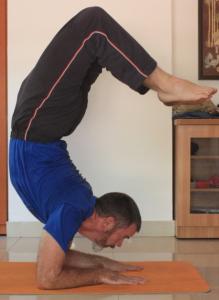During the last half of April, I taught a kid’s camp at a1000 yoga‘s Kormangala studio. Below are some ideas about my experience.

The Playful Scorpion
1.) Kids can’t down shift from 4th to 1st like adults. This was once a major point of frustration for me in teaching kids. When you ask kids to settle down after an activity they were really excited about, there’ll be a lag. There’s a temptation to see this unresponsiveness as a lack of respect, but it probably isn’t. (Which isn’t to say that the kiddies never attempt to test the waters.) The fact is that adults don’t get so amped up, and so it’s not so difficult for them settle down. Instead of getting frustrated with the kids, maybe one should feel sorry for the adults.
2.) Kids need a more advanced class, but not because they’re more advanced. Attention to detail isn’t a child’s strong suit. They have difficulty focusing on the finer points of alignment and breath–unless they’ve found a fun challenge in the pose. During the camp, we played with vrschikasana (scorpion pose) during the first few days. That’s not something I would do with adults. Kids get in the zone and, therefore, they don’t tense up and injure themselves so easily.
3.) Kids are natural flow hackers. If you don’t know what “flow” is, I’d recommend Mihaly Csikszentmihalyi’s book Flow, Steven Kotler’s The Rise of Superman, or Marer / Buzady / Vecsey’s Missing Link Discovered. (Depending upon your point of interest: psychology, athletics, or business, respectively.) However, in a nutshell, flow is the state of mind in which we perform at our best because of a combination of concentration and the quieting of one’s inner critic. One of the keys to catching the flow is finding a challenge of the appropriate level. The challenge should be just beyond one’s current capability. If it’s too easy, one gets bored. If it’s too difficult, one gets frustrated. Children instinctively seek out the Goldilocks’s zone in challenges.
I noticed this when we were playing a game in which each kid had to cross the floor walking only on wooden yoga blocks. This helps with balance, which tends to be a weakness among kids. Every time all the kids have finished crossing, a block or two is removed. So, the game gets harder the longer it goes on. The position of the remaining blocks can be adjusted, and, after a while, the kids wanted to adjust the blocks themselves because I was making it too easy. In other words, they wanted to make gaps that they would have to stretch to their utmost to succeed.
4.) Don’t assume that kids experience fear the same way you do. I suspect there may be some readers who will say, “that guy had kids doing scorpion on their second day of yoga, he must be a complete lunatic.” But, adults superimpose their fears on children. Kids’ excitement more easily overcomes their anxieties. In my last post on yoga, I referred to a FaceBook meme that I saw recently that said, “A child who falls down 50 times learning to walk, never says, ‘I don’t think this is for me.'” Somewhere along the line, people become mortified of failure or the risk of a bruise, but it’s not in childhood.
Have you ever seen a child fall down and start to get up–everything apparently fine–until he or she sees the gasp from mom (or another adult,) and then the child bursts into tears? If you’re the adult in the aforementioned scenario, let me suggest that teaching kids physical activities isn’t yet for you–at least not until you can manage your own anxiety a bit better. That’s not to say that there’s anything wrong with such people, but a teacher’s job is to show the child a world of possibilities and not to infect them with his or her own limitations.
5.) Finding the balance between inner child and outer adult can be a challenge, but is necessary. My working theory is that kids don’t trust an adult whose inner child doesn’t show through at least a little bit. Kid’s yoga is typically taught differently from the adult version. When teaching adults, one doesn’t practice alongside the students, but that’s the norm in teaching kids. (Kids can mimic better than they can follow complex verbal instructions.) The kids enjoy having the teacher participate, but one must also ensure that it remains clear who is the teacher. Otherwise, kids may be confused. When you’ve been participating in practice, playing games, and letting the children have some say in what they do (which is also a sound practice to some degree) they may gradually start to forget about your role as authority figure.
By B Gourley in Children, exercise, fitness, teaching, yoga on May 2, 2016.